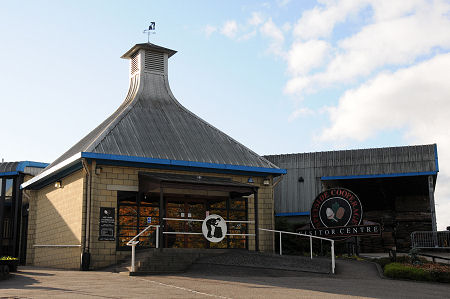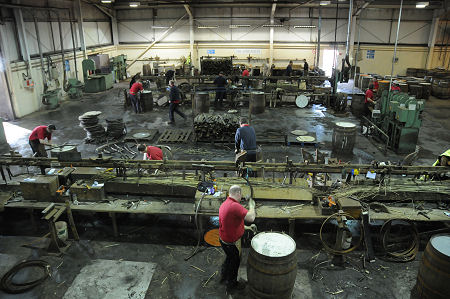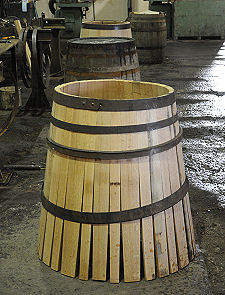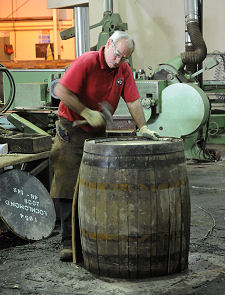 Speyside Cooperage |
The Speyside Cooperage is accessed from the A941 Dufftown road a short distance south of Craigellachie. There is a large visitor car park which is obvious as you enter, and disabled parking is available a little further beyond, close to the visitor centre itself.
As you walk up to the visitor centre from the car park you pass a picnic area off to one side, complete with shelters made from huge barrels and the figure of a person made from a number of different size barrels. The entrance to the visitor centre is obvious from its rising metal clad roof, topped off with the traditional badge of a distillery, the pagoda that would have sat on top of a kiln. The Speyside Cooperage's pagoda never saw active service, but it is no less appropriate in its location than the disused pagodas which top off many distilleries today, and it certainly ensures that no-one misses the link between the cooperage and the dominant industry of the area, the distillation of Scotch whisky.
There was a time when just about every Scotch whisky distillery had its own cooperage, just as there was a time when just about every Scotch whisky distillery had its own working floor maltings whose kiln was topped off with a smoking pagoda. In both cases that time has long gone, and only a handful of either now remain. Most distilleries now buy in their malted barley from industrial maltings. And most distilleries now have their cooperage needs met by the Speyside Cooperage.
Yet while the move to industrial maltings has largely done away with the craft and the manual skill (and the sheer hard work) associated with the traditional floor maltings, the move to what is effectively a centralised cooperage has simply brought all the traditional skills together in one place. The actual process remains very much the same as it has for many centuries, as do the tools and the enormous amount of experience and skill needed to do the job properly. And there is no mechanical assistance: the job of a cooper today is as physically demanding as it has always been.
The Speyside Cooperage is a remarkable fusion of two very different worlds. The visitors on the one hand, and the industry they have come to see on the other. The front of the cooperage is very focused on the needs of visitors. To one side of the main reception is a very well stocked shop, carrying a rather wider range of goods than you'd find in a typical distillery shop, and, of course, something of an emphasis on craft gifts and wooden products. Beyond the shop is the Speyside Cooperage's coffee shop with tables and chairs, of course, made from casks.
Those visiting the Cooperage pass through the reception to the "Acorn to Cask" exhibition which sets out the story of casks and the art of the cooper. There is then a short video about the cooperage before you move on to what for many will be the main attraction. This comprises an L-shaped gallery at first floor level along two sides of the production area, with glass windows along one side. What you see from the gallery is probably unlike anything you will ever have seen before.
In terms of scale of activity, the cooperage looks and feels a little like a large production line, perhaps in a car engine plant. But the similarities run dry when you realise that everything below you is being done by hand. Individuals are working extremely hard, and extremely quickly (they are paid by output) on lots of individual items. There is no "line" as such: each cooper takes a job, collects what is needed to do it, takes the cask or parts to his working area, and does the job, before moving it on to the testing and storage area towards the rear of the cooperage. Watch for a little while and you begin to think that you are looking at an activity that is essential medieval in nature: apart from the red sweatshirts, these coopers could be part of a scene taking place at the time of Robert the Bruce, or in any era since.
For visitors in the viewing galleries above, the effect is mesmeric. The galleries are also home to a series of interesting displays about the art of the cooper, and it is even possible to try your hand yourself, assembling the component parts of two small barrels. We doubt that anyone would think this an easy task, but if they did, a few tries would soon put them right!
The Speyside Cooperage was established in 1947 by the Taylor family and has gone from strength to strength ever since. They operate three cooperages in total: one in Craigellachie, one in Broxburn in West Lothian, and one in Shepherdsville in Kentucky. Since 2008 the company has been part of the French "François Frères" group.
The cooperage effectively does three similar but different jobs. Firstly it builds new casks for use in the brewing industry, which explains the scatter of fresh wood casks you are likely to see on your visit. The second job is to rebuild American barrels previously used for storing bourbon so they can be used by Scottish distilleries for maturing Scotch whisky. It helps to know a little background here. The spirit that emerges from the spirit still in a Scotch whisky distillery is clear and most certainly not whisky. It gains its colour and much of its flavour during a maturation process that by law must be for a minimum of three years and usually lasts for 10, 12, 18 or more years.
Scotch whisky is usually matured in casks that have previously been used to store Spanish sherry or American bourbon. Under US law it is illegal to mature bourbon in anything other than fresh oak barrels, so once they have been used once, they are no longer of any use to the industry. The needs of both bourbon and Scotch whisky distillers, and the legal requirements in both countries, are met if the bourbon barrels are used once in the States, then broken down and brought to Scotland for reassembly and filling with Scotch whisky. Much of that reassembly takes place at the Speyside Cooperage. The added twist is that the standard size of a bourbon barrel is rather smaller than the standard size of a Scotch whisky cask, so more staves and are added and larger hoops used when reassembly takes place: for every five broken down US barrels, only four casks are reconstructed in Scotland.
The third job undertaken at the Speyside Cooperage is the refurbishment and repair of casks already in use by distilleries. In total the Speyside Distillery produces, assembles or repairs over 100,000 casks each year. Meanwhile casks that are beyond repair are turned into garden furniture, or simply chipped for use as fuel in Scotland's many smokehouses.
 The Cooperage Seen from the Visitor Gallery |

|
|
|
Visitor InformationView Location on MapSTB 5 Star Visitor Attraction Dufftown Road, Craigellachie, AB38 9RS. Tel: 01340 871108. enquiries @speysidecooperage.co.uk Grid Ref: NJ 293 442 www.speysidecooperage.co.uk Opening Hours Admission Accessibility What3Words Location: ///lists.straws.immune |
 Picnic Area Picnic Area |
 Shop Shop |
 Inside the Shop Inside the Shop |
 Cafe Cafe |
 Part of the
Exhibition Part of the
Exhibition |
 Make Your Own |
 One of the Stacks of Casks |
 And Another One |
 Plenty of Metal Hoops Plenty of Metal Hoops |







